12 January 2014 Edition
The links between the undercover death squads and Westminster’s military and political machine
Collusion went all the way to the top
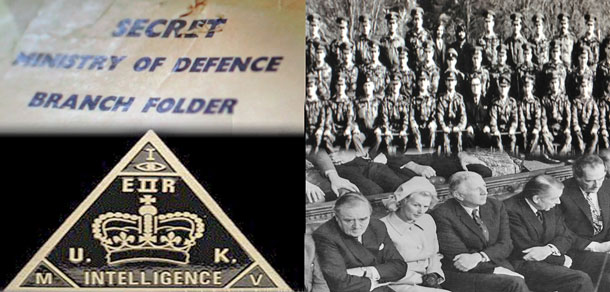
• ‘Collusion is the control, resourcing and direction of these death squads by British state agencies. Those who sanctioned the policy of collusion have never been held accountable’
‘The policy of collusion was much more sophisticated and had tangible and direct links through its chain of command to the British Cabinet’
‘The FRU was answerable to the Task Co-ordinating Group, comprised of the heads of the RUC Special Branch, the RUC Chief Constable and various intelligence services . . . reports to the North’s Secretary of State and directly accountable to the Joint Intelligence Committee comprised of Cabinet members and senior Ministry of Defence figures. The JIC is directly answerable to the British Prime Minister’
“THE KILLING OF CITIZENS through collusion with unionist death squads is a British state policy in Ireland,” pressure group Fírinne defines collusion in its campaign to expose the links between the British and pro-British, unionist killer gangs.
“Collusion is the control, resourcing and direction of these death squads by British state agencies. Those who sanctioned the policy of collusion have never been held accountable . . .
“Collusion has not ended.
“The British apparatus which operates the policy of collusion continues in existence.
“Until the mechanisms have been dismantled, the strategy disowned and the truth revealed, collusion cannot be consigned to the history books.”
The deadly links between the British state and its allies in the unionist death squads have come under a high degree of scrutiny in the past months in a newly-written book by a journalist who spent many years reporting on the ground in Ireland and the prestigious BBC TV Panorama news investigation programme.
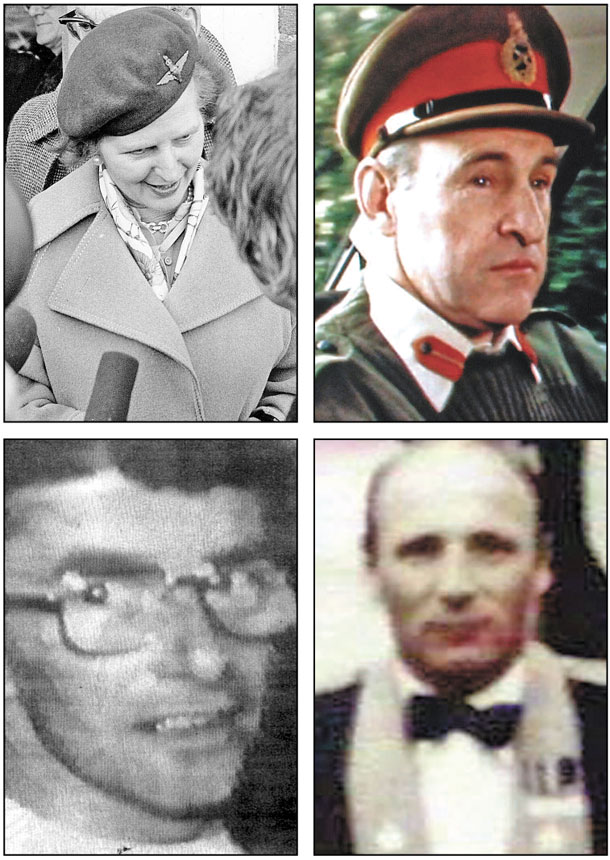
• (clockwise from top left) Prime Minister Margaret Thatcher, Brigadier Frank Kitson, Colonel Gordon Kerr and British Army Intelligence agent Brian Nelson
In her recently-published book, Lethal Allies: British Collusion in Ireland, Anne Cadwallader lifts the lid on the notorious south Armagh based Glenanne Gang, mainly made up of serving or recent former members of the Royal Ulster Constabulary (RUC) paramilitary police and the locally-recruited and then biggest regiment in the British Army (since dissolved), the Ulster Defence Regiment (UDR).
Using declassified official Whitehall Government and Ministry of Defence documents, the former BBC journalist, now a caseworker with the Pat Finucane Centre, demonstrates that successive British governments were aware of the involvement of members of the British crown forces with unionist assassination squads responsible for the deaths of 120 people and did nothing to prevent the slaughter.
Their inaction – ‘turning a blind eye’ – can only be interpreted as approval for those responsible for a killing spree throughout Counties Armagh, Tyrone, Down, Louth and Monaghan; ‘The Triangle of Death’, as it was labelled by Fr Raymond Murray and Fr Denis Faul.
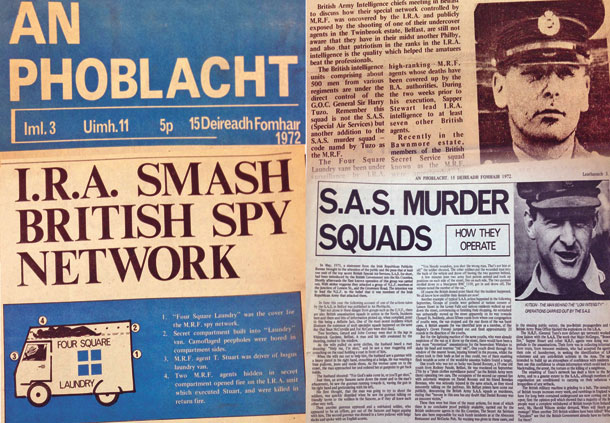
• Reports on the IRA attacks which targeted the Four Square Laundry and Gemini Health Studios spy operations
Hot on the heels of the Cadwallader exposé at the end of 2013 was a BBC Panorama programme looking into a secretive British Army undercover unit, the Military Reaction Force (MRF).
Broadcast on November 21 2013, Panorama’s Britain’s Secret Terror Force carried interviews with British soldiers who disclosed that the unit “acted like a terror group” and admitted that members of the unit killed at least two people and wounded many more in ‘drive-by shootings’.
The unit was clearly and unashamedly used by the British state, its army, police and intelligence services – and its political leaders – to terrorise the nationalist population of republican west Belfast, where it was largely deployed.
Made up of hand-picked British Army soldiers, the MRF also recruited members of the nationalist population who in turn carried out attacks on targets within west Belfast. The unit also ran a number of front companies to gather intelligence. In October 1972, the IRA uncovered and attacked two of the MRF’s bogus front companies spying and gathering intelligence on targets: the ‘Four Square’ mobile laundry service and the ‘Gemini Health Studios’ massage parlour.
When it was dissolved, around 1973, the MRF’s operational records were destroyed. Its commanders and its members are retired on British Army pensions paid by the British Government and the British taxpayer.
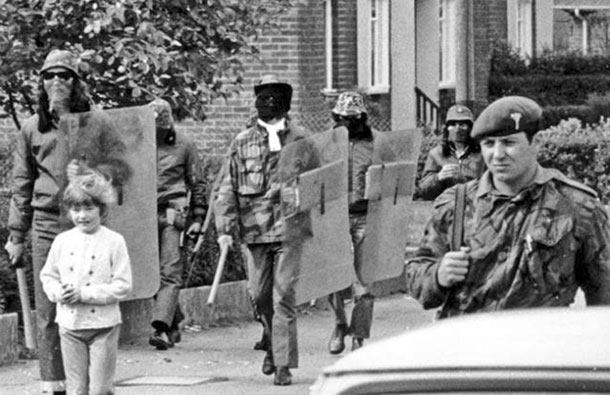
• (Top) UDA death squad members openly patrol alongside British troops in Belfast and (bottom) the aftermath of one of the car-bombs which exploded in Dublin and Monaghan in May 1974, killing 33 civilians
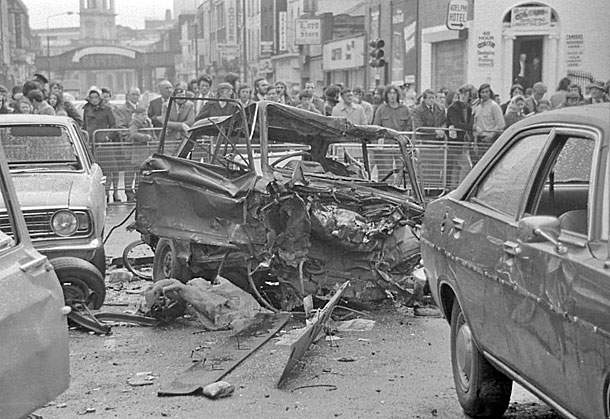
While the MRF may have been disbanded, it was succeeded by the Special Reconnaissance Unit (SRU), or 14 Intelligence Company (14 Int), and, later by the Force Research Unit (FRU), according to research carried out by Margaret Urwin, secretary to the Justice for the Forgotten, now an arm of the Pat Finucane Centre, which focuses on attacks in the 26 Counties and particularly the Dublin and Monaghan bombings of 17 May 1974 in which 33 civilians were killed and 300 wounded – the highest number of casualties in any one day during the conflict.
In January 2013, in the wake of the report by Sir Desmond de Silva QC into the killing of human rights lawyer Pat Finucane, Urwin and Spinwatch Public Interest Investigations (a non-profit company based in England and Wales) released a report tracing the roots of the covert relationship between the British and unionist death squads back to the earliest days of the conflict.
Counter-Gangs: A History of Undercover Military Units in Northern Ireland 1971-1976 shows how the application of colonial counter-insurgency theory led to the recruitment of local people by plainclothes British Army units in the early 1970s.
The report is based on years of work, including interviews with former members of the crown forces and extensive documentary research.
Among its key findings are that senior British Army officers ordered subordinates in late 1971 to develop informal contacts with loyalist paramilitaries, described as “unofficial unarmed bodies . . . working in the public interest”.
Thus the MRF came into being.
The subsequent exposure of MRF activities led to their replacement a year later by a larger and more professional unit, the Special Reconnaissance Unit (SRU).
The SRU relied heavily on SAS personnel. Successive governments went to great lengths to conceal this fact from the Houses of Parliament at Westminster and the media to be able to deny any SAS role in the North of Ireland.
Deliberately misleading information about the undercover units was fed to the press as part of a ‘black propaganda’ campaign.
Counter-Gangs is the most comprehensive study on the MRF and its successor, the Special Reconnaissance Unit.
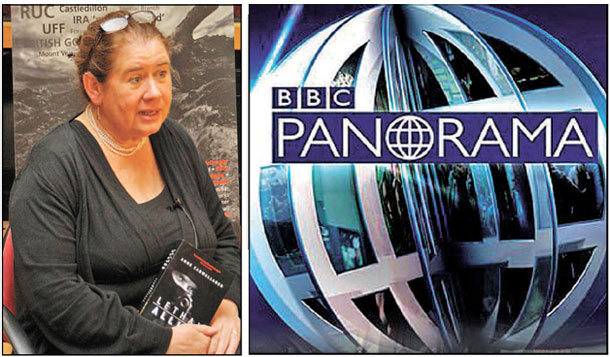
• Anne Cadwallader’s ‘Lethal Allies’ book and Panorama have shed a light on high-level collusion
The report is the first of the ‘State Violence and Collusion Project’, an online research collaboration between Spinwatch and the Pat Finucane Centre.
Looking at the evidence, it is clear that the ‘unofficial’ Glenanne Gang and the British Army and state-backed Military Reaction Force are two sides of the one military coin.
But to see the real story of collusion we need to get into the lift and go up to the top floor. There we will find the policy framework for collusion.
This was set, mostly, by Brigadier Frank Kitson the pre-eminent counter-insurgency strategist of the 1970s.
A military intelligence veteran of Britain’s colonial wars in Malaya, Kenya, Aden and Cyprus, Kitson’s deployment to the North heralded the development of strategies based on his seminal military textbook, Low Intensity Operations: Subversion, Insurgency and Counter-Insurgency.
Kitson describes counter-insurgency as “those military, paramilitary, political, economic, psychological and civic actions taken by a government to defeat subversion and insurgency”.
He advocated “liaison with an organisation, of friendly guerrilla forces, operating against the common enemy”.
Kitson (who served in the North of Ireland in the early 1970s) oversaw the establishment of the MRF and the heavy infiltration of loyalist organisations such as the UDA and UVF.
According to Relatives for Justice in their booklet, Collusion (June 2002), the FRU (also known as 14th Intelligence) replaced the MRF.
“The policy of collusion was much more sophisticated and had tangible and direct link through its chain of command to the British Cabinet,” Relatives for Justice say.
Colonel Gordon Kerr took command of the unit and reinstated long-time British Army and intelligence agent Brian Nelson.
Commentators have long attempted to disguise the real role of units like the MRF, FRU or indeed the UDR and RUC personnel who made up the Glenanne Gang as ‘renegades’ or ‘rotten apples’.
The chain of command, as outlined by Relatives for Justice, tells a different story.
“The FRU was answerable to the Task Co-ordinating Group (TCG), which is comprised of the heads of the RUC Special Branch, the RUC Chief Constable and various intelligence services all relating directly to affairs on the ground. The TCG has responsibility for deploying the SAS and other covert operations.
“It also reports to the North’s Secretary of State. In turn, the TCG is directly accountable to the then Joint Security Committee (JSC), now Joint Intelligence Committee (set up under the Intelligence Act 1994) in London which is comprised of Cabinet members and senior MOD figures. The JIC is directly answerable to the British Prime Minister and has the final say in all security matters.
“During the 1980s, Margaret Thatcher occasionally chaired the JIC.”
This is why Fírinne say that the strategy must be disowned and the truth revealed before collusion can be consigned to the history books.
Lethal Allies: British Collusion in Ireland (Anne Cadwallader, Mercier Press, 2013) chronicles the killings of 120 people by the Glenanne gang, a unionist death squad that operated with impunity because many of its members were serving or recent ex-members of the RUC and UDR.
Others were agents acting in the state’s interest, acting as deniable ‘surrogates’ to prosecute Britain’s ‘dirty war’ against the IRA and outspoken nationalists.
Ironically, most of the documents used in the text came from de-classified British Government files and information gleaned from reports compiled by the Historical Enquiries Team (HET).
What Cadwallader has done, using her wealth of investigative journalistic experience, is to link the information, look for patterns and draw out the connections between people, events and weapons to reveal the extent of state involvement in the many attacks and killings.
The attitude of the judiciary is part of the story and instructive in the way judges showed extraordinary leniency to killers.
Cadwallader writes that Brigadier Kitson took the view that the law be “used as just another weapon in the government’s arsenal . . . the activities of the legal services have to be tied into the war effort”.
In the case of James Mitchell, an RUC Reservist involved in two attacks that left five people dead and whose farm was central to the Dublin/Monaghan bombings, we see the outworking of Kitson’s philosophy and military doctrine that was taught at Britain’s prestigious Sandhurst Military Academy. Mitchell was only ever convicted of possession and given a one-year suspended sentence.
Lethal Allies sets us the task of redefining collusion as a central plank of British Government policy and strategy in Ireland.
The breadth and width of collusion — from the counter-gang theory of Kitson to the operation of the FRU and its successors by the Ministry of Defence and Britain’s intelligence services — tells us that collusion went all the way to the top.




